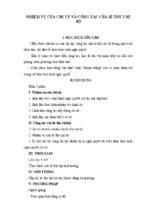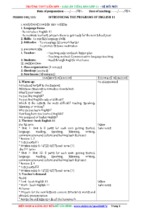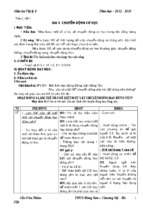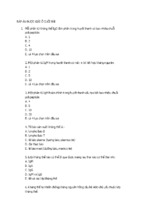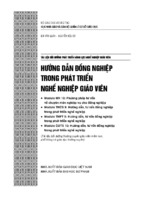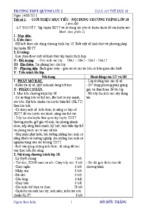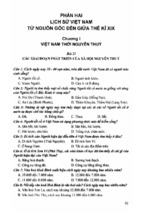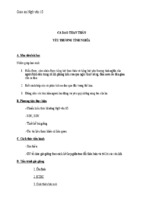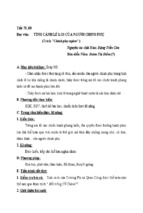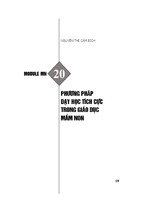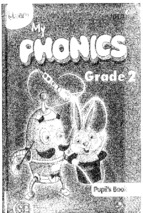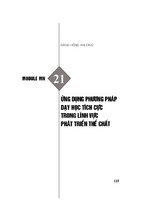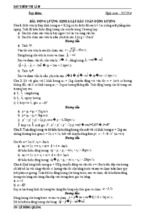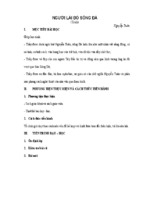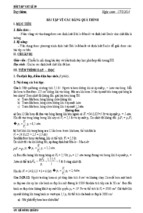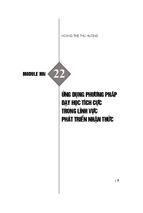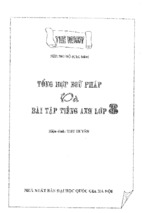Week 1
Period 1
Date:15/ 8/ 2013
Revision
A. Objectives:
- By the end of the lesson, students will be able to memorize those grammar items
and know how to deal with English 8
B. Teaching aids: Textbooks (English7 and English 8), poster
C. Procedures:
Teacher
Students
I. Warm up : Greetings
II. Presentation
A. Tenses
* The Future Simple:
- Asks students to repeat forms and use of
the tense.
- Writes the form and use on the board
- Explains some more about the Future
Simple
* The Past Simple:
- Asks students to repeat forms and use of
the tense.
- Writes the form and use on the board
- Explains some more about the Past Simple,
V-ed and the past forms of irregular verbs
*Practice Exercises: (poster)
a. Put the verbs in brackets in the Future
Simple
1. My sister (be) 18 next year
2. He (be) busy tomorrow.
3. Next year, they (build) a new school.
4. Next summer, I (go) to Ha Long Bay.
5. If I have time, I (come) to see you
6. Tomorrow evening, we (have) a meeting
7. They (not/go) to school this Sunday
8. We (visit) our teacher next Saturday
b. Put the verbs in brackets in the Past
Simple
1. They(go) to Ha Long for their last
summer vacation
2. She (receive) a lot of gifts on her birthday
3. I (be) in Ho Chi Minh City for one week.
4. Nam (watch) TV last night
1
- Repeat forms and use of the tense
Form: S + will/ shall + V (infinitive)
S + won’t/ shan’t + V (infinitive)
Will + S + V (infinitive)?
Use: To talk about future actions or events
- Listen and take note
- Repeat the forms and use of the tense
Form: S + was/ were……………
S + V-ed/ past form of irregular
verbs………
S +didn’t + V (infinitive)
Did + S + V (infinitive)?
Use: To talk about past actions or events
- Do the exercise individually, then
compaare with a partner. Then some
students go to the board to do the exercise
Answer key
- will be
- will be
- will build
- will go
- will come
- will have
- won’t go
- will visit
- Do the exercise individually, then
compare with a partner
- Some students do the exercise on the
board
The answer key
- went
- received
5. I (arrive) home at 11 o’clock last night
6. Lan (not/ go) to school yesterday
-gives feedback and corrects
B. Comparisons:
How many types pf comparisions are there?
What are they?
- Asks students to repeat forms of the
comparisions
- Explains some more about comparisons
- was
- watched
- arrived
- didn’t go
- There are three types of comparisions.
- Repeat the forms of the comparisions
* Comparatives:
+ short adj: adj+ er than…..
+ long adj: more + adj than…….
* Superlatives:
+ short adj: the adj+ est…….
* Exercise: (poster)
+ long adj: the most+ adj ……..
Use the correct forms of the adjectives in - Listen and take note
brackets
- Do the exercise individually then
1. Fruit is (good) candy.
compare with a partner. Some students
2. Cars are (fast) bicycles.
read the answers aloud.
3. Winter is (cold) summer.
Answer key
4. Dogs are (friendly) cats.
- better than
5. Mai is (good) student in my class.
- faster than
6. Russia is (large) country in the world.
- colder than
- Gives feedback and corrects
- friendlier than
- the best
C. Introduction to English8:
- the largest
- There are 16 units (8 units each semester)
- Listen to the teacher.
- There are 7 sections in each unit:
1. Getting Started
2. Listen and Read
3. Speak
4. Listen
5. Read
6. Write
7. Language Focus
- Explains some more about English 8
III. Homework:
- Guides students to prepare new lesson for - Listen and take note
the next lesson.
Goodbye.
Goodbye.
Week: 1
Unit 1: My friends
Period: 2
Getting Started + Listen and Read
Date:16/ 8/ 2013
A. Objectives:
- By the end of the lesson, students will be able to study and memorize new
words to talk about their friends.
- Train reading and listening skills.
2
- To educate students polite attitude in describing their friends
B. Teaching aids: Tape, cassette, poster
C. Procedure:
Teacher
Students
I. Warm up:
Getting Started -P10
-T: “Look at the pictures. These are activities
that Ss often do, now answer my questions ”
+ What are these children doing?
+ Where are they?
+ Are they all boys?
+ Do girls play soccer?
+ Do you like soccer?
+Do you play soccer and where do you often
play
soccer?
- Asks Ss to ask and answer the same questions
with each picture.
- Introduces the lesson: Today you are going to
listen and read the dialogue between Hoa and
Lan
II. Presentation:
Vocabulary
- (to) seem (translation): dường như
- (to) look like (example): trông gióng như
- a next-door neighbor (explanation): người hàng
xóm
- a smile (translation): nụ cười
Checking vocab: Rub Out and Remember
- Sets the scene: “Look at this picture. They are
Hoa and Nien. And now you listen to the
dialogue between Hoa and Lan, Hoa is talking
about her friend Nien.”
Pre- questions: (poster)
T: “First, you guess and answer these questions”
a. Where does Nien live?
b. How old is Nien?
c. Is she a beautiful girl?
- Listen
- Answer
- Work in pairs
- Pay attention
- Repeat in chorus
- Repeat individually
- Detemine meanings and acent marks
- Copy
- Remember then rewrite the new words
- Listen to the teacher.
- Look at the questions then work in
pairs guessing the answers for the
questions
Answer key
- in Hue
- twelve
III. Practice:
- yes, she is.
- Asks students to listen to the tape and check the - Listen twice and check the answers for
answers for the pre- questions.
the questions
- Gets feedback and corrects
- Call out the answers
- Asks students to practice the dialogue
- Work in pairs (closed pairs) practicing
3
- Introduces model sentense:
She was not old enough to be in my class.
- Concept check
Comprehension questions: P 11
- Asks students to answer the questions
- Gets feedback and corrects Ss’answers
- Calls some pairs to practice before the class
- Corrects Ss’ pronunciation
the dialogue
- Listen and take note
- Work in pairs (closed pairs)
- Call out the answers
Answer key
a. She lives in Hue.
b. No, she doesn’t.
c. “She wasn’t old enough to be in my
class”
d. She is going to visit Hoa at Christmas
- Practice again
- Work individually writing the
sentences, then compare with a partner.
- Some students go to the board to
correct the wriitng.
IV. Production:
Writing: word cues (poster)
a. Lan/ Hoa’s best friend.
b. They/ same class/ Quang Trung School.
c. Last year/ Hoa/ to school/ first time.
d. Lan/ show/ around/ introduce/ new friends.
- Asks Ss to write sentenses using the word cues
- Calls some sts to go to the board to write the
sentences on the board.
- Gives feedback and corrects
V. Homework:
- Learn the new words by heart
- Write the answers in Listen and Read 2 in your - Listen and take note.
Ex- book
- Do Ex7- P11 (workbook)
- Guides sts to prepare for the new lesson.
Goodbye.
Goodbye
Week: 1
Period: 3
Date:17 /8/ 2013
Unit 1: My friends
Speak + Listen
A. Objectives:
- By the end of the lesson, students will be able to describe people, then listen to
the tape and complete the conversation using the expressions given on page 13.
- Train speaking and listening skills.
- To educate students respecful attitude to adults in communication.
B. Teaching aids: Pictures
C. Procedure:
Teacher
Students
I. Warm up:
Brainstorming
- Asks students to think of the adjectives used to - Give 2 lists of adjs that Ss have learnt
4tall
describe body build and hair
long
hair
body build
To describe people’s apearance.
- Introduces the lesson: Today you are going to
speak about people’s appearance
II. Presentation:
Vocabulary:
- curly (adj) (picture): quăn, xoăn
- blond (adj) (picture): vàng hoe
- bald (adj) (picture): hói (tóc )
- slim (adj) (explanation): mảnh dẻ
- straight (adj) (example): thẳng
- principal (n) Thầy hiệu trưởng
Checking vocab: Slap the board
* Speaking
Presentation Dialogue:
- T: “Look at this picture. They are Hoa and Lan.
Hoa is describing someone and asks Lan to
guess. Now listen to their conversation”
- Reads the dialogue twice
- Asks some students to practice the dialogue
before the class.
Model Sentenses:
- Elicits the models from students
She is short and thin.
She has long blond hair
Concept check:
- explains some more about the verbs be/ have
- Listen to the teacher.
- Listen then repeat in chorus
- Repeat individually
-Determine meanings and acent marks.
- Copy
- Work in groups of 4 slap on English
words when hearing teacher read
Vietnamese meanings
- Pay attention.
- Listen
- Work in pairs (closed pairs) to
practice the dialogue
- Listen and take note.
- A st translate the sentence into
Vietnamese.
- Detemine form and use
Form: S + be + adj….
S + have/ has + adj + hair
Use: To talk about someone’s body
Picture Drill: P11-13
build and hair
- Gives instructions: Now take turns to make - Pay attention
similar dialogues describing the people in the
pictures, using the adjectives in the table-P11
Example:
T: He is short and fat. He has bald black hair.
- work in pairs making similar
S1: Is this Mr Lai?
dialogues to describe the people in the
T: Yes.
pictures.
- Asks students to practice the same
- Some pairs practice their dialogues in
- Calls on some pairs to demonstrate their front of class.
dialogues before the class.
5
- Gives feedback and corrects.
* Listen: Sets the scene.
- Asks Ss to work in pairs, guessing the
expressions to complete the conversstions on P13.
- Gets feedback.
- Turns on the tape. Asks Ss to listen to the tape
and correct the predictions.
- Asks ss to listen to the tape again and complete
the conversations.
- Gets feedback and corrects.
III. Production:
- Asks students to describe someone in the class
with their partners
- Gives feedback and corrects
IV. Homework:
- Learn the new words by heart
- Guides students to do exercises in workbook
and prepare for the next lesson.
Goodbye
6
- Listen to the teacher then work in
pairs completing the conversations
using the expressions gigen.
- Listen to the tape and check the
predictions.
- Listen to the tape again and complete
the conversations.
- Some Ss to practice the conversations
before class.
- Work in pairs describe someone in
class, then read the descriptions aloud
in front of class.
- Listen and take note.
Goodbye.
Week: 2
Period: 4
Date:19 /8/ 2013
Unit 1: My friends
Read
A. Objectives:
- By the end of the lesson, students will be able to describe their friends.
- Train reading comprehension skill.
- To educate studens how to keep a true friendship
B. Teaching aids: Pictures, poster
C. Procedure:
Teacher
Students
I. Warm up: Greeting
Chatting
- Asks students some questions about their
friends:
Do you have any friends?
Where do they live?
Who is your best friend?
What does he/ she look like?
What is he / she like?
- Introduces the lesson: Today you are going
to read a text about Ba and his friends
II. Pre- reading
1. Pre- teach vocabulary:
- character (n) (expl): tính cách
- orphanage (n) (expl): trại trẻ mồ côi
- sense of humor (n phrase)(example): khiếu
hài hước
- sociable (adj)(expl): dễ hoà đồng
- reserved (adj) (expl): kín đáo, dè dặt
- tell jokes (v) (example): nói đùa
- outgoing (adj) (= friendly): thân thiện, cởi
mở
Checking vocab: Rub Out and Remember
2. Set the scene: “Look at this picture. They
are friends. Now you read a text in which
someone describes some of his friends. First,
you guess information about the text”
T/F Statements Prediction: (poster)
a. Ba has only three friends: Bao, Song and
Khai. (F )
b. Ba and his friends have the same
characters. (F )
c. Bao, Song and Khai are quite reserved in
7
Greeting
- Answer (WC )
- Pay attention
- Listen carefully
- Repeat in chorus
- Repeat individually
- Determine meanings and acent marks
- Copy
- Remember then rewrite the words
- Pay attention
- Work in pairs to guess
- Call out the guesses
public. (F )
d. They all enjoy school and study hard. ( T )
- Asks Ss to guess the T/F Statements
- Gets feedback and writes some guesses on
the board
III. While- reading
- Asks students to read the text once and
check their predictions.
- Gets feedback and corrects.
Multiple choice
- Asks Ss to read the text again and do Ex1-P
14
- Asks Ss to give their answers.
- Gives feedback and corrects.
Comprehension questions
- Asks Ss to do Ex2- P14
- Gets feedback and corrects.
- Read silently and check the
predictions.
- Call out the answers.
Answer key:
a- F/ b- F /c- F /d- T
- Read the text again
- Work in pairs to do the multiple
choice.
- Give the answers
Answer key
a-A
c-B
b-C
d-D
- Work in pairs asking and answering
comprehension questions.
- Call out the answers
Answer key
a. Ba feels lucky having a lot of friends.
b. Bao is the most sociable.
c. Khai likes reading.
d. A bad thing about Ba’s jokes is that
sometimes his jokes annoy his friends.
e. Bao spend his free time doing
IV. Post- reading
volunteer work at a local orphanage.
- Asks students to talk to one another about f. ( students’ answers.)
their friends using the adjectives they have -Work in pairs talking about their
just learnt.
friends. Then some students talk in
- Calls on some students to check
front of class.
- Gets feedback and corrects
Guessing games( For good students)
- Go to the board to describe one of
- Call on one student to go to the board and their friends. Others listen then guess
describe one of the students of the class.
who they are.
- Asks the others to guess
V. Homework
Listen and take note.
- Guides students to do exercises 4-6 P8-18
in workbook and prepare writing for the next
lesson.
Goodbye.
Goodbye.
8
Week: 2
Period: 5
Date: 20 /8/ 2013
Unit 1: My friends
Write
A. Objectives:
- By the end of the lesson, (For weak Ss) students will be able to answer all the
questions in the textbook using simple sentences, (for good Ss) they will be able to
write a paragraph about their friends.
- Train wrting skill
- To educate students what to do to become a good friend,
B. Teaching aids: Poster
C. Procedure:
Teacher
I. Warm up:
Students
Networks
sociable
tall
characters
appearance
reserved
- Two students write on the board
- Others think of adjectives used to
talk
about
appearance
and
characters.
thin
- Calls on 2 students to the board to write out the
adjectives used to talk about appearance and
characters.
- Gets feedback and corrects.
- Introduces the lesson: In today’s lesson, you are
going to learn to write a paragraph about your
friends
II. Pre- writing
1. Pre- teach vocabulary
humorous (adj) (explanation): hài hước
- helpful (adj) (explanation): hay giúp đỡ
2. Reading comprehension
- Asks Ss to read the information about Tam and
the paragraph about Tam, and then answer some
questions
Comprehension questions (written on poster)
- Reads each question and calls on Ss to answer
1. What’s his name?
9
- Pay attention
- Listen carefully
- Repeat in chorus
- Repeat individually
- Copy
- Read the form and the paragraph
silently
- Answer the questions
(WC )
2. How old is he?
3. What does he look like?
4. What is he like?
5. Where does he live?
6. Who does he live with?
7. Who are his friends?
- Corrects if necessary
- Asks Ss to work in pairs to answer the same
questions about themselves and take notes of the
answers
- Calls on some students to check and correct
mistakes if necessary
III. While- writing
- Asks Ss to write a paragraph about their partner
using the notes they have just taken
- Monitors and helps weaker students
-Work in pairs asking and answering
questions about themselves
- Write down a paragraph based on
the form.
Sample writing
His name is Nguyen Van A. He is
thirteen years old. He lives at 24
Tran Phu street with his parents and
his elder brother B. He is tall and
thin. He has an oval face and short
IV. Post- writing
black hair. He is sociable, humorous
Correction: Sharing
and helful. His best friends are Nam
- Asks students to swap their writing and correct and Minh.
mistakes for each other
- Swap and correct mistakes for each
- Calls on some students to read out their other
writings
- Read out the writing
- Gives feedback and corrects some typical
mistakes
- Listen and correct mistakes.
IV. Homework
- Learn the new words by heart.
- Write a short paragraph to describe another - Listen and take note
friend.
- Guides students to do exercise 7 P11 in
workbook (explain how to do it)
Goodbye.
Goodbye.
Week: 2
Period: 6
Unit 1: My friends
10
Language Focus
Date: 21 /8/ 2013
A. Objectives:
- By the end of the lesson, students will be able to further practice in Simple
Present/ Past Simple and practice using the structure: (not) adjective + enough to
infinitive and do all the exercises using these grammar items.
- Train doing exercise skills.
B. Teaching aids: Poster, workbook 8
C. Procedure:
Teacher
Students
I. Warm up:
- Asks students to give the past forms of the
verbs given below
Live
lived
Go
Show
Write
Remember
Like
- Gives feedback and corrects
- Introduces the lesson: Today you are going to
continue to learn Unit 1, Language Focus 1-2,3
II. New lesson: Review and practice:
1. Present Simple Vs Past Simple
- What’s the form of the Present Simple?
- What’s the use?
- What’s the form of the Past Simple?
- What’s the use of the Past Simple?
- Explains some more about the two tenses
- Write the past forms of the verbs on
the board
- Pay attention
- Answer
S + V(s/es)……….
S + don’t / doesn’t + Vinf……….
Do/ does + S + Vinf?
Yes, + S + do/ does/ No, + S + don’t/
doesn’t.
It is used to talk about habitual
actions or general truths
- Repeat the form of the past simple
tense.
S + V-ed………..
S + didn’t + Vinf…………
Did + S + Vinf?
Yes, + S + did/ No, + S + didn’t.
It is used to talk about actions or
events happening and finishing in the
past
III. Practice:
Language Focus 1-2 (P 16)
- Work individually doing the
- Gives instructions: Use the correct forms of exercise then compare with a partner.
11
the verbs in brackets
- Asks students to do the exercises
-Asks Ss to give the answers
- Gives feedback and corrects
* (not) adj + enough to- infinitive
- Sets the scene: Do you know why Nien
wasn’t Hoa’s classmate?
Concept check: what’s it in Vietnamese?
What’s the form? What’s its use?
- Asks Ss to practice
Word Cue Drill (written on poster)
a. read English books in English/ (yes) good
b. drive a car/ (no) old
c. carry this bag/ (yes) strong
d. do the exercise/ (no) clever
- Gives a model:
Can you read English books?
Yes. My English is good enough to read books
- Asks Ss to practice
- Gives feedback and corrects
Language Focus 4
- Gives instructions: Complete the dialogues
using (not) adjective + enough
- Asks Ss to practice
- Asks Ss to read out their answers
- Gives feedback and corrects
IV. Further Practice:
Language focus 3
- Gives instructions
- Asks students to do the exercise: work in
pairs, ask and answer the questions about the
picture.Then some pairs practice in front of
class.
- Gets feedback and corrects.
V. Homework
- Guides sts to do exercise 8- 10 in workbook
and prepare for the next lesson.
Goodbye.
Week: 3
Period: 7
Date: 28/ 8/ 2013
- Some students read the answers in
front of class.
- Answer teacher’s question
Because she was not old enough to
be in her class.
- A st translates the sentence into
Vietnamese.
Form:
S + be (not) + adj + enough toinfinitive
Use: To express affimative meaning.
Đủ… làm gì.
- Work in pairs asking and answering
the questions using the cues given.
- Some pairs practice in front of
class.
- Pay attention
- Repeat in chorus
- Repeat individually
- Copy
- Work in pairs doing the exercise.
- Some pairs practice in front of
class. Some other sts go to the board
to correct the exercise in writing.
Listen and take note.
Goodbye.
UNIT 2: MAKING ARRANGEMENTS
GETTING STARTED – LISTEN AND READ
12
A. Objectives:
- By the end of the lesson, students will be able to make and confirm
arrangements on the phone.
- Train skill making plans on the phone
- Educate students cultural of communication on the phone
B. Teaching aids: Cassette, tape and extra board
C. Procedure:
Teacher
Students
I. Warm up:
Getting Started:
Matching
- Asks Ss to look at the pictures on page 18 - Work in pairs matching the items
and match each object with its name
with the pictures
- Gets feedback and corrects Ss’ answers
- Some sts read the answers and their
translations aloud.
- Gives Ss pronunciation and asks Ss to Answer key
practice reading these new words
a. an answering machine máy ghi lời
nhắn
b. a mobile phone điện thoại di động
c. a fax machine
máy fax
d.a telephone directory:danh bạ điện
thoại
e. a public telephone điện thoại công
cộng
II. Presentation:
f. an address book
sổ ghi địa chỉ
* Sets the scene: “You are going to listen to a - Pay attention
conversation between Nga and Hoa on the
phone. What do you think they are talking
about? ”
* Pre- questions: (Extra board)
a. What are Nga and Hoa going to do this - Read the sentences individually then
evening?
work in pairs guessing the answers for
b. How is Hoa going to the movie theater?
the questions.
c. Where are they going to meet?
- Then some pairs report their results.
d. What time are they going to meet?
III. Practice: (Cassette + CD)
- Asks students to listen to the dialogue and - Pay attention and check the answers.
check the answer for the pre- questions.
- Practice the dialogue in pairs.
- Asks sts to practice the dilogue in pairs, then - Some pairs practice the dialogue in
some pairs practice in front of class.
front of class.
13
Model sentences:Review:
Eg: I’m going to see the movie Dream City
- Concept check:
- Asks students to practice the dialogue
- A student translate the sentence into
Vietnamese.
Form: S + Be(am/ is/ are) + going +
to Infinitive
Use: To talk about intentions and
Comprehension questions:
activities in the future.
- Asks students to answer the questions
- Work in pairs asking and answering
- Gets feedback and corrects Ss’ answers
comprehension questions. Then some
pairs practice in front of class.
- Calls on some pairs to practice before the Answer key
class
a. Nga did/ made the call.
- Corrects Ss’ pronunciation
b. Nga did/ introduced herself.
c. Nga did/ invited Hoa to the movies.
d. Nga arranged a meeting place.
e. Hoa did/ arranged the time.
IV. Production:
f. Nga did/ agreed to the time.
* For bad and average students:
- Asks them to practice the dialogue between
Hoa and Nga
*For good students : Role play
- Asks Ss to read the dialogue again and make - Bad and average students practice the
a similar dialogue
dialogue again
- Calls on some pairs to practice their dialogue -Good students work in pairs practice
before the class
the dialogue then make similar
- Gives feedback and corrects
dialogues.
V. Homework:
- Practice again
- Guides students to do exercises 1-2 P15-16 - Listen and take note.
in the workbook and prepare for the next
lesson.
Goodbye.
Goodbye.
Week 3
Period 8
Date: 2/ 9/ 2013
Unit 2: Making arrangements
Lesson 2: Speak + Listen
14
A. Objectives:
- By the end of the lesson, students will be able to make arrangements on the
phone and listen to a telephone conversation for specific information.
- Train speaking and listening skills
- Educate students cultural of communication on the phone
B. Teaching aids: Cassette + CD, picture, extra board
C. Procedure:
Teacher
Students
I. Warm up
- Asks Ss to practice saying the telephone
numbers
+ Are you on the phone?
+ What’s your phone number?
+ How often do you use your phone?
- Introduces the lesson: Today you are going to
practice making arrangements on the telephone
and listen to the telephone conversation to fill in
the missing information
II. Presentation
Pre – teach vocabulary:
- concert
(n) (expl): buổi hoà nhạc
- band
(n)(example): ban nhạc
- message
(n)(realia):
lời nhắn
leave a message (v)(expl): để lại lời nhắn
- make an appointment (v)(expl): hẹn
- the principal (n)(example): thầy hiệu trưởng
- available(adj) (example):
có sẵn
Checking vocab: Rub Out and Remember
* Speak
1 Ordering: Speak 1 (Page 20)
- Asks Ss to put the sentences in the right orders
to make a complete conversation
- Gives feedback and corrects
- Work in open pairs asking and
answering the questions
- Pay attention
- Listen carefully
- Repeat in chorus
- Repeat individually
- Determine meanings and acent
marks.
- Copy
- Remember then rewrite the new
words
- Work in pairs ordering the sentences
to make a complete dialogue
- Call out the answers
Answer key
1 - b 4-a
7–e
10- h
2-f
5- i
8–k
11- d
3-j
6- c
9–g
- Practice the dialogue in pairs, then
- Asks Ss to practice the dialogue
some pairs practice the dialogue in
front of class.
2. Practice
- Pay attention
- Sets the scene: “Look at this picture”. They are - Work in pairs to complete the
Ba and Bao. They are talking on the phone to dialogue. Then practice it.
15
make arrangements to play chess.”
- Asks Ss to complete the dialogue
- Gives feedback and corrects
- Asks Ss to practice the dialogue
* Listening
1. Pre- listening
- Sets the scene: Mrs. Nguyen is talking to the
secretary of Kingston Junior High School on the
phone. She wants to speak to the principal but he
is out, so she leaves a message.
- Runs through the form (written on extra board)
- Asks Ss to guess and fill in the missing
information
2. While- listening (cassette + CD)
- Lets students listen to the tape and check their
predictions.
- Asks Ss to listen once more
- Gets feedback and corrects
Possible answers:
Bao: May/ Can I speak to Ba, please?
This is Bao.
Bao: I’m fine, thanks. And you?
Bao: Can you play chess tonight?
Bao:
What
about
tomorrow
afternoon?
Bao: I’ll meet you at the Central
Chess Club.
Bao: Is 2.00 OK?
- Pay attention
- Look at the form in students’ book
- Guess
- Listen to the tape twice
- Check the predictions
- Listen and check again
- Call out the answers.
Answer key
Date:(Ss’answer Time: (Ss’ answer)
For:
The principal
Message: Mrs. Mary Nguyen wanted
to see you at 9.45 in the morning.
Tel number: 6468 372 0942
III. Production
Role play( for good sts)
- Use information from the two
- Asks students to use the two dialogues to make dialogues
to
make
similar
similar arrangements
arrangements.
- Calls on some pairs to demonstrate their - Some pairs practice their dialogues
dialogues before the class
in front of class.
- Gives feedback and corrects
IV. Homework
- listen and take note.
- Write the dialogue in Speak 2 in your Ex-book
- Guides sts todo exercise 1,2 P15, 16 in
workbook and prepare for the nextlesson.
Goodbye.
Goodbye
Week: 3
Period: 9
Date: 3/ 9/ 2013
UNIT 2; MAKING ARRANGEMENTS
LESSON 3: READ
16
A. Objectives:
- By the end of the lesson, students will be able to know something about
Alexander Graham Bell who invented the telephone.
- Train reading comprehension skill.
- Educate students respecsful attitude to the inventor.
B. Teaching aids: Pictures, extra board.
C. Procedure:
Teacher
I. Warm up:
Brainstorming
to chat
Students
to inform
- WC
What is the
telephone used for?
- Asks students to make a list of the uses of the
telephone and write on the board
- Gives feedback and corrects
- Introduces the lesson: Today you will read a
passage about Alexander Graham Bell who
invented the telephone.
II. Pre- reading:
1. Pre- teach vocabulary:
- emigrate (v)(expl): xuất cảnh, di cư
- transmit (v)(expl): truyền, phát (tín hiệu)
- conduct = carry out(v):thực hiện, tiến hành
- demonstrate (v) (expla): chứng minh, biểu diễn
- device
(n) (example): thiết bị
- deaf- mute (n) (expl): người câm điếc
- experiment with (v)(trans): thí nghiệm với
- assistant (n) (trans)
người phụ tá
Checking vocab: Slap the board
2 T/F Statements Prediction: (Extra board)
Read 1 ( P 22 )
- Runs through the statements
- Asks Ss to guess the T/F Statements
- Gets feedback and writes some guesses on the
board
III. While- reading:
- Asks students to read the text and check their
predictions.
17
- Write the uses of the telephone on
the board
-Listen carefully
- Repeat in chorus
- Repeat individually
- Determine meanings and acent
marks
- Copy
- Work in 2 groups of 5
- Listen to the teacher
- Read the true or false statements
on page 22 then work in pairs to
guess
- Call out the guesses
- Read silently and check the
predictions.
- Gets feedback and corrects.
- Call out the answers.
Answer key
a-F
d-F
b-F
e-F
c-T
f-T
- Asks Ss to correct the false statements
- Correct the false statements
a: ….Edinburgh
d:….in 1876
b:….at Boston University e:…
Ordering (Read 2)
speech over a long distance
- Asks Ss to read the text again and put the events - Read the text again then work in
in the right orders according to the time
pairs putting the events in the
- Asks Ss to give their answers.
correct orders.
- Gives feedback and corrects.
- Read out the answers
Answer key
Guessing the meaning from the context: (Extra
d - e - a- g - c - b - f
board)
- Guess the meaning of the words
Scotsman
nghĩ ra, tìm thấy
and match
speech
lời nói
exhibition
người X cốt len
come up with
triển lãm
(to) be in use
nhiều, vô số
countless
được sử dụng
- Asks Ss to guess and match some new words - Listen and repeat
with their meanings
- Read the new words again
- Reads these new words
- Calls some students to read the new words
- Corrects Ss’ pronunciation
IV. Post- reading: Write- it- up( for good sts)
- Asks Ss to use their own words to write a - Work individually writing a
paragraph about Alexander Graham Bell
paragraph about Alexander Graham
- Calls on some students to read their writing
Bell.
- Gives feedback and corrects
- Some sts read the writing aloud
V. Homework:
- Guides students to do homework and prepare - Listen and take note
for the next lesson.
Goodbye
Goodbye.
Week: 4
Period: 10
Date: 4/ 9/ 2013
Unit 2: Making arrangements
Lesson 4: Write
18
A. Objectivies:
- By the end of the lesson, students will be able to write a telephone message.
- Train wriitng skill
- Educate students comunicating culture on the phone.
B. Teaching aids:
C. Procedures:
Teacher
Students
I. Warm up:
Check up
- Calls on students to read and translate the
reading text into Vietnamese
- Gives feedback and corrects.
- Introduces the lesson: Today you are going to
learn how to write a telephone message
II. Pre- writing:
Vocabulary
- a customer (explanation): khách hàng
- a delivery(translation): việc vận chuyển
- stationery (unc) (example): văn phòng phẩm
- an order (explanation): đơn đặt hàng
- service (translation): dịch vụ
Checking vocab:
Slap the board
Gap-fill
- Asks Ss to read the message and fill in the gaps
in the passage in Write 1 (P 23 )
- Calls on some students to check their answers
- Corrects if necessary
- Read and translate
- Pay attention
- Repeat in chorus
- Repeat individually
- Copy
- Work in groups of 4
- Work in pairs
- Call out the answers
Answer key
1. telephoned
5. name
2. May 12
6. delivery
3. speak
7. Mr Ha
III. While- writing:
4. took
8. at
- Gives instructions: Now read the passage on - Pay attention
P23, then write the telephone message.
- Asks Ss to read the passage and write a message - Work individually
using the information from the passage
IV. Post- writing:
Correction
- Calls one student to write his/ her writing on the - Write on the board
board
- Asks other students to swap their writing and - Swap and correct mistakes for each
correct mistakes for each other
other
- Calls on some students to read out their writings - Read out the writing
- Gives feedback and corrects some typical Sample writing
mistakes
Thanh Cong Delivery Service
19
Date: June 16
Time: after midday
For: Mrs van
Message: Mr Nam called about his
stationery order. He wanted you to
meet him at 8 634 082.
Taken by: Mr Toan
* Asks students question: What do you have to do - We have to use polite language and
when you answer the phone then take message? polite attitude.
V. Homework:
- Learn the new words by heart.
- Write the message in Ex3 in your exercise book - Listen and take note
- Guides sts to prepare for the new lesson.
Good bye!
Goodbye.
Week 4
Period: 11
Date: 12/ 9/ 2013
Unit 2: Making arrangements
Lesson 5: Language Focus
A. Objectives:
20
- Xem thêm -

